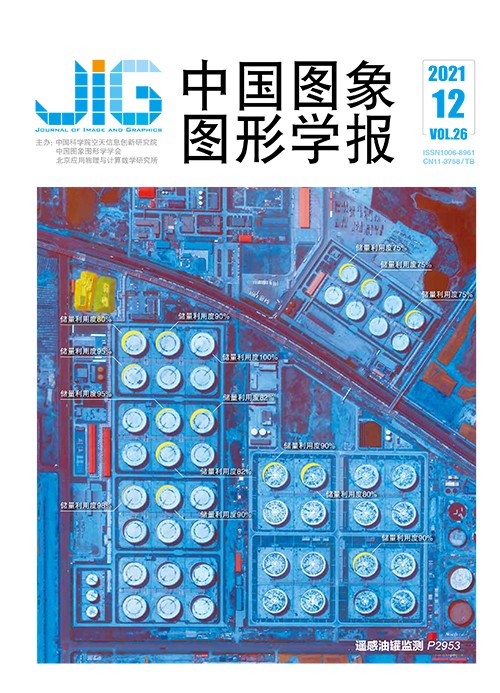
改进Mask R-CNN模型的海洋锋检测
徐慧芳1,2, 黄冬梅1,3, 贺琪1, 杜艳玲1, 覃学标1(1.上海海洋大学信息学院, 上海 201306;2.上海建桥学院信息技术学院, 上海 201306;3.上海电力大学, 上海 201306) 摘 要
目的 海洋锋的高效检测对海洋生态环境变化、渔业资源评估、渔情预报及台风路径预测等具有重要意义。海洋锋具有边界信息不明显且多变的弱边缘性,传统基于梯度阈值法及边缘检测的海洋锋检测方法,存在阈值选择不固定、判定指标不一致导致检测精度较低的问题。针对上述问题,基于Mask R-CNN(region convolutional neural network)提出一种改进的海洋锋自动检测方法。方法 兼顾考虑海洋锋的小数据量及弱边缘性,首先对数据扩增,并基于不同算法对海表温度(sea surface temperatures,SST)遥感影像进行增强;其次,基于迁移学习的思想采用COCO(common objects in context)数据集对网络模型进行初始化;同时,对Mask R-CNN中残差神经网络(residual neural network,ResNet)和特征金字塔模型(feature pyramid network,FPN)分别进行改进,在充分利用低层特征高分辨率和高层特征的高语义信息的基础上,对多个尺度的融合特征图分别进行目标预测,提升海洋锋的检测精度。结果 为验证本文方法的有效性,从训练数据和实验模型上分别设计多组对比实验。实验结果表明,相比常用的Mask R-CNN和YOLOv3(you only look once)神经网络,本文方法对SST梯度影像数据集上的海洋锋检测效果最好,海洋锋的定位准确率(intersection over union,IoU)及检测平均精度均值(mean average precision,mAP)达0.85以上。此外,通过对比分析实验结果发现,本文方法对强海洋锋的检测效果明显优于弱海洋锋。结论 本文根据专家经验设立合理的海洋锋检测标准,更好地考虑了海洋锋的弱边缘性。通过设计多组对比实验,验证了本文方法对海洋锋的高精度检测效果。
关键词
Ocean front detection method based on improved Mask R-CNN
Xu Huifang1,2, Huang Dongmei1,3, He Qi1, Du Yanling1, Qin Xuebiao1(1.College of Information Technology, Shanghai Ocean University, Shanghai 201306, China;2.College of Information Technology, Shanghai Jian Qiao University, Shanghai 201306, China;3.Shanghai University of Electric Power, Shanghai 201306, China) Abstract
Objective The efficient detection of ocean front is of great significance to study the efficient detection of ocean front for marine ecosystem, fishery resources assessment, fishery forecast and typhoon track prediction. Gradient threshold method and edge detection algorithm have been widely used in ocean front detection. Traditional gradient method mainly depends on the gradient threshold, the sea area with gradient value greater than the set threshold has been regarded as the existence of ocean front. However, the selection criteria of threshold cannot tailor the requirements of accurate detection of complex and diverse ocean fronts due to artificial setting dependence, so it is more suitable for the object detection with fixed edge (such as land). During to the weak edge information of ocean front, it is difficult to achieve the good effect through the traditional edge extraction algorithm. A new automatic detection method to detect the small data volume and weak marginal characteristics of ocean fronts has been considering. Based on the advantages of the Mask R-CNN (region convolutional neural network) for instance segmentation, an improved Mask R-CNN network has been applied to the detection of ocean fronts. The ocean front detection method based on the modified Mask R-CNN has evolved the establishment of ocean front detection standards and data preprocessing, such as data expansion, data enhancement and labeling operations. High-precision detection of ocean fronts has been realized based on multiple iterations of training and parameter correction. Method First, the remote sensing images have been performed expansion operations for the small amount of data and the weak edge characteristics, such as rotating, flipping and cropping. Total 2 100 images have been obtained including 800 original images, 500 rotation and flip processing images and 800 random cropping processing images. Meanwhile, sea surface temperatures (SST) remote sensing images have been enhanced based on deep closest point (DCP) and contrast limited adaptive histogram equalization (CLAHE) algorithms. Next, based on migration learning, using the general image classification network model trained on the common objects in context (COCO) dataset as the pre-training model, and using training datasets to train the pre-trained model. In order to meet the needs of ocean front detection, the residual network (ResNet) and feature pyramid network (FPN) model in Mask R-CNN have been optimized respectively. Limited training data leads to over fitting of the deep residual network and poor detection results. Considering the scarcity of ocean front data and the difficulty of constructing training set, the shallow ResNet-18 network has been used to detect ocean front. Multi-scale fusion feature maps have been predicted to enhance the detection effect of ocean front respectively through the full use of the high-resolution and high-level semantic information of low-level features. Result In order to verify the effectiveness of the method, three training datasets of grayscale image, RGB image and gradient image have been designed. Using LabelMe software to label the dataset, and then achieving high-precision detection of ocean fronts by multiple iterations of training and parameter correction. In addition, the weighted harmonic mean Micro-F1 and intersection over union (IoU) have both been used to evaluate the detection accuracy and target location accuracy of the model. In the experiment and analysis section, several groups of comparative experiments have been designed from experimental model. In order to evaluate the robustness and effectiveness of the method, images collection of global ocean fronts has been conducted to make three different datasets and perform multiple different iterations on the datasets. The results have shown that the training has effectively converged, and the detection accuracy of the model has also increased, reaching more than 0.85 after 25 000 iterations. In order to further verify the proposed ocean front detection results based on Mask R-CNN, the three training sets have been trained separately. The experimental results have shown that gradient images have been both higher than RGB images and grayscale images to detect ocean fronts, the positioning accuracy and detection accuracy. In order to highlight the advantages of this model for ocean front detection, this research has compared it with you only look once (YOLOv3) and Mask R-CNN models under three different datasets. The three training datasets have been trained for 30 000 times under different models. The results have demonstrated that the positioning accuracy IoU and accuracy F1 of the ocean front detection method proposed are improved. The detection accuracy of this method is 84.33%, and Micro-F1 is 86.57%. Compared with the YOLOv3 and Mask R-CNN algorithms, the Micro-F1 value has increased by 4.27% and 3.01% respectively. Rapid identification of ocean fronts is the key to practical fishery applications. The running time of the RGB image set under different network models and different iteration times has been presented. Under different iterations, the proposed model takes much less time than YOLOv3. At last, in order to evaluate the effectiveness of the method in the detection of strong and weak fronts, the strong and weak fronts in the three datasets have been screened and trained separately. The results have shown that the accuracy of the method in the detection of strong ocean fronts can be achieved all above 80% higher. Conclusion A reasonable ocean front detection standard has been setup combined with the weak edge characteristics of ocean front. By designing some comparative experiments to verify the high-precision detection effect of the method proposed in this paper on ocean fronts.
Keywords
|



 中国图象图形学报 │ 京ICP备05080539号-4 │ 本系统由
中国图象图形学报 │ 京ICP备05080539号-4 │ 本系统由